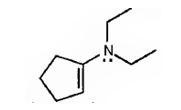
a) CH3CH2CONHCH3
Interpretation:
To prepare the given amides by using an acid chloride and an
Concept introduction:
Evidently, in deciding the starting materials (reagents) for the synthesis, we observe that there are two distinct parts of the amide viz the acyl part  which should come from the respective acyl chloride viz propanoyl chloride; and the amine part
which should come from the respective acyl chloride viz propanoyl chloride; and the amine part  , which should come from the oppropriate amine methylamine.
, which should come from the oppropriate amine methylamine.
b) N,N-Diethylbenzamide
Interpretation:
To prepare the given amides by using an acid chloride and an amine or ammonia.
Concept introduction:
Evidently, introspection of the target molecule viz the amide, shows that it has two distinct parts, viz the acyl part, Phco should come from the acid chloride, viz benzoyl chloride, and the amine part should come from the appropriate amine, in this case it is N,N-diethyl amine.
c) Propanamide
Interpretation:
To prepare the given amides by using an acid chloride and an amine or ammonia.
Concept introduction:
Introspection of the target amide shows that there are two distinct parts viz, the acyl part and the amine part the acyl part should come from the appropriate acid chloride in this case, it is propanoyl chloride while the amine part should be provided from ammonia.
Trending nowThis is a popular solution!

Chapter 21 Solutions
Organic Chemistry
- What acyl chloride and amine are required to synthesize the following amides?a. N-ethylbutanamide b. N,N-dimethylbenzamidearrow_forwardGive the products expected when the following tertiary amines are treated with a peroxyacid and heated.(a) N,N-dimethylhexan-2-aminearrow_forwardShow how to synthesize the following amines from the indicated starting materials.(a) N-cyclopentylaniline from aniline (b) N-ethylpyrrolidine from pyrrolidinearrow_forward
- Give the products expected when the following tertiary amines are treated with a peroxyacid and heated.N,N-diethylhexan-2-aminearrow_forwardWhen a amide is treated with SOCl2 ? What arises ?arrow_forwardShow how to prepare the following aromatic amines by aromatic nitration, followed by reduction. You may use benzene andtoluene as your aromatic starting materials. c) m-bromoanilinearrow_forward
- Show how to prepare the following aromatic amines by aromatic nitration, followed by reduction. You may use benzene andtoluene as your aromatic starting materials. (c) m-bromoaniline (d) m-aminobenzoic acidarrow_forwardIndicate whether the following statement is true or false. Aliphatic amines are more basic than ammonia, whereas aromatic amines are less basic than ammonia. When amines are reacted with bases, they form ammonium salts. Benzenesulfonyl chloride or p-toluenesulfonylchloride give N-substituted sulfonamides with primary and secondary amines. Derivative of primary amines is insoluble in dilute NaOHarrow_forwardN-Nitroso amines are stabilized by electron delocalization. Write the two most stable resonance contributors of N-nitrosodimethylamine, (CH3)2NNO.arrow_forward
- Draw the products formed when each attached amine is treated with [1] CH3I(excess); [2] Ag2O; [3] Δ. Indicate the major product when a mixtureresults.arrow_forwardWhat carboxylic acid and amine are needed to synthesize the pain reliever phenacetin? Phenacetin was once a component of the over-the-counter pain reliever APC (aspirin, phenacetin, caffeine), but it is no longer used because of its kidney toxicity.arrow_forwardAccount for the following :(i) Primary amines (R-NH2) have higher boiling point than tertiary amines (R3N).(ii) Aniline does not undergo Friedel – Crafts reaction.(iii) (CH3)2NH is more basic than (CH3)3N in an aqueous solution.arrow_forward

 Organic ChemistryChemistryISBN:9781305580350Author:William H. Brown, Brent L. Iverson, Eric Anslyn, Christopher S. FootePublisher:Cengage Learning
Organic ChemistryChemistryISBN:9781305580350Author:William H. Brown, Brent L. Iverson, Eric Anslyn, Christopher S. FootePublisher:Cengage Learning

